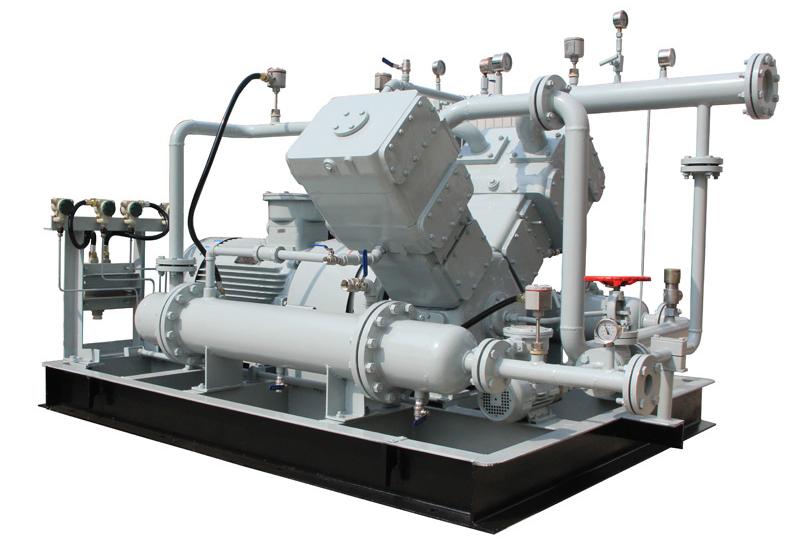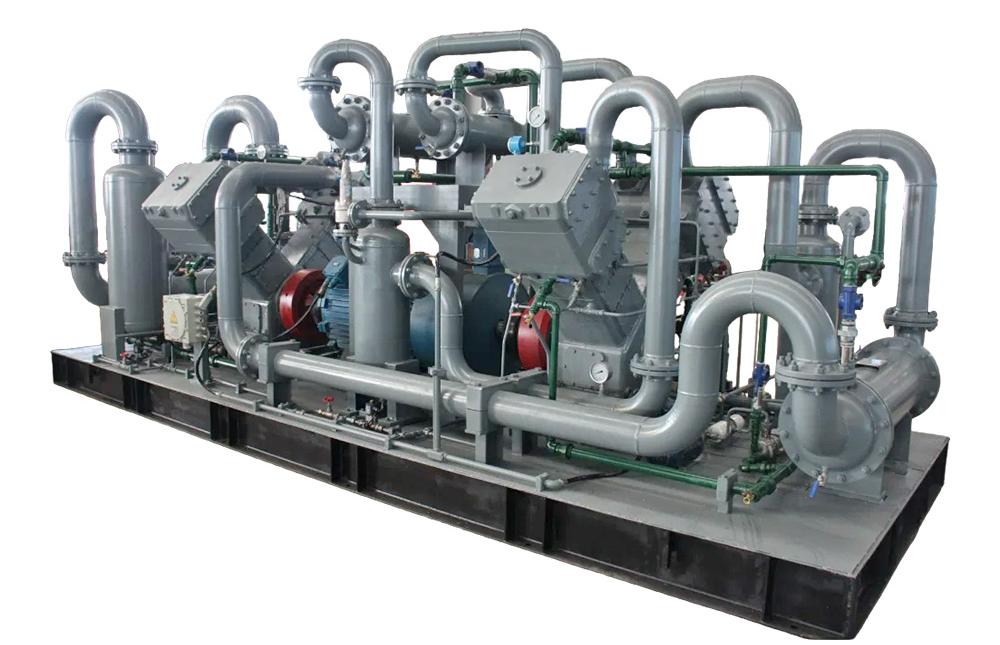Piston gas compressors (reciprocating compressors) have become core equipment in industrial gas compression due to their high-pressure output, flexible control, and exceptional reliability. This article systematically elaborates on their technical advantages in multi-type gas compression scenarios, based on structural design principles.
I. Core Structural Design
The performance of piston gas compressors stems from a precisely coordinated component system, including the following key parts:
1. High-Strength Cylinder Assembly
Constructed from cast iron, alloy steel, or specialized coating materials to withstand long-term corrosion from aggressive media such as acidic gases (e.g., H₂S) and high-pressure oxygen.
Integrated water/oil cooling channels to precisely manage temperature fluctuations caused by gas properties (e.g., low viscosity of hydrogen, high reactivity of ammonia).
2. Multi-Material Piston Assembly
Piston Crown: Material selection tailored to gas chemistry—e.g., 316L stainless steel for sulfur-containing gas corrosion resistance, ceramic coatings for high-temperature CO₂ environments.
Sealing Ring System: Utilizes graphite, PTFE, or metal composite seals to prevent leakage of high-pressure gases (e.g., helium, methane), ensuring compression efficiency ≥92%.
3. Intelligent Valve System
Dynamically adjusts intake/exhaust valve timing and lift to accommodate varying gas densities and compression ratios (e.g., nitrogen at 1.5:1 to hydrogen at 15:1).
Fatigue-resistant valve plates endure high-frequency cycling (≥1,200 cycles/minute), extending maintenance intervals in flammable/explosive gas environments.
4. Modular Compression Unit
Supports flexible 2- to 6-stage compression configurations, with single-stage pressure up to 40–250 bar, meeting diverse needs from inert gas storage (e.g., argon) to syngas pressurization (e.g., CO+H₂).
Quick-connect interfaces enable rapid cooling system adjustments based on gas type (e.g., water cooling for acetylene, oil cooling for Freon).
II. Industrial Gas Compatibility Advantages
1. Full Media Compatibility
Corrosive Gases: Enhanced materials (e.g., Hastelloy cylinders, titanium alloy piston rods) and surface hardening ensure durability in sulfur- and halogen-rich environments.
High-Purity Gases: Oil-free lubrication and ultra-precision filtration achieve ISO 8573-1 Class 0 cleanliness for electronics-grade nitrogen and medical oxygen.
Flammable/Explosive Gases: Compliant with ATEX/IECEx certifications, equipped with spark suppression and pressure fluctuation dampers for safe handling of hydrogen, oxygen, CNG, and LPG.
2. Adaptive Operational Capabilities
Wide Flow Range: Variable-frequency drives and clearance volume adjustment enable linear flow control (30%–100%), suitable for intermittent production (e.g., chemical plant exhaust recovery) and continuous supply (e.g., air separation units).
Smart Control: Integrated gas composition sensors auto-adjust parameters (e.g., temperature thresholds, lubrication rates) to prevent malfunctions caused by sudden gas property changes.
3. Lifecycle Cost Efficiency
Low Maintenance Design: Critical component lifespans extended by >50% (e.g., 100,000-hour crankshaft maintenance intervals), reducing downtime in hazardous environments.
Energy Optimization: Compression curves tailored to gas-specific adiabatic indices (k-values) achieve 15%–30% energy savings compared to conventional models. Examples include:
Compressed air: Specific power ≤5.2 kW/(m³/min)
Natural gas boosting: Isothermal efficiency ≥75%
III. Key Industrial Applications
1. Standard Industrial Gases (Oxygen/Nitrogen/Argon)
In steel metallurgy and semiconductor manufacturing, oil-free designs with molecular sieve post-treatment ensure 99.999% purity for applications like molten metal shielding and wafer fabrication.
2. Energy Gases (Hydrogen/Syngas)
Multi-stage compression (up to 300 bar) combined with explosion suppression systems safely handles hydrogen and carbon monoxide in energy storage and chemical synthesis.
3. Corrosive Gases (CO₂/H₂S)
Customized corrosion-resistant solutions—e.g., tungsten carbide coatings and acid-resistant lubricants—address sulfur-rich, high-humidity conditions in oilfield reinjection and carbon capture.
4. Specialty Electronic Gases (Fluorinated Compounds)
Full-seal construction and helium mass-spectrometer leak detection (leak rate <1×10⁻⁶ Pa·m³/s) ensure safe handling of hazardous gases like tungsten hexafluoride (WF₆) and nitrogen trifluoride (NF₃) in photovoltaic and IC industries.
IV. Innovative Technological Advancements
Digital Twin Systems: Real-time data modeling predicts piston ring wear and valve failures, enabling maintenance alerts 3–6 months in advance.
Green Process Integration: Waste heat recovery units convert 70% of compression heat into steam or electricity, supporting carbon neutrality goals.
Ultra-High-Pressure Breakthroughs: Pre-stressed winding cylinder technology achieves single-stage compression >600 bar in lab settings, paving the way for future hydrogen storage and transport.
Conclusion
Piston gas compressors, with their modular architecture and customization capabilities, deliver reliable solutions for industrial gas processing. From routine compression to extreme-condition specialty gas handling, structural optimizations ensure safe, efficient, and cost-effective operations.
For compressor selection guides or technical validation reports tailored to specific gas media, please contact our engineering team.
Technical Notes:
Data derived from ISO 1217, API 618, and other international testing standards.
Actual performance may vary slightly depending on gas composition and environmental conditions.
Equipment configurations must comply with local safety regulations for special equipment.
Post time: May-10-2025



